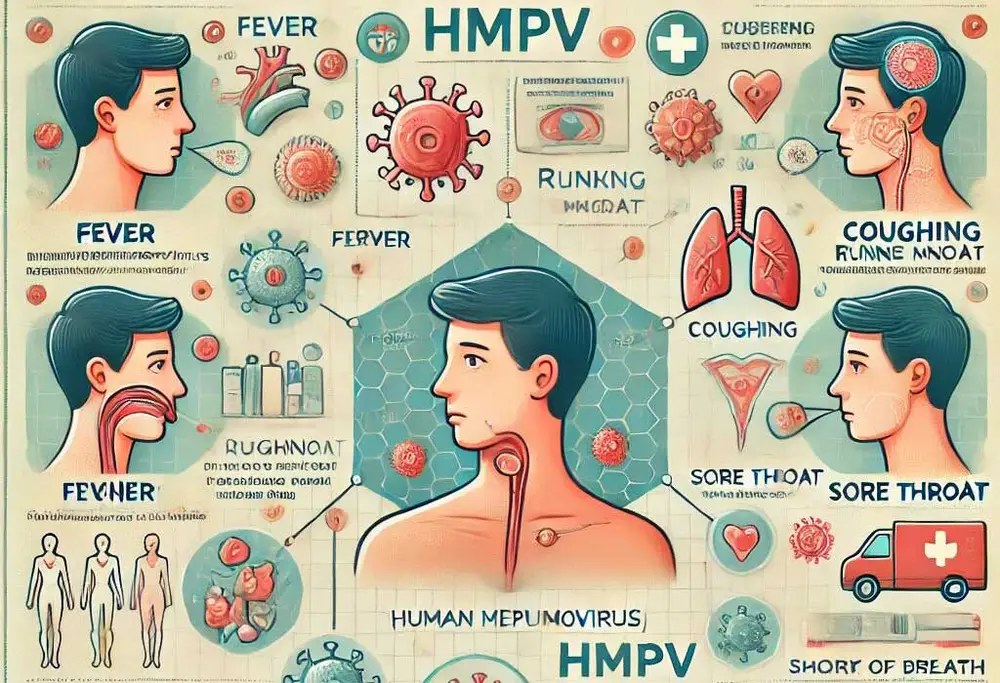What is Human Metapneumovirus (hMPV)
Human metapneumovirus is a commonly detected respiratory virus, most often associated with mild symptoms and upper respiratory tract infections, like the common cold. It peaks during the time of winter and early spring, along with the time of RSV and influenza seasons. Most infections relate to minor complaints. Still, young children, older adults, and immunocompromised persons are the ones more prone to developing a severe infection.

hMPV is an extremely common virus; most people become infected with this virus before the age of five. This virus is believed to be among the top ten leading causes of acute respiratory infections. Human metapneumovirus was first identified by a team of Dutch scientists in 2001. The team was led by Bernadette G. van den Hoogen.
Cause
Human Metapneumovirus (HMPV), is an enveloped virus with a single-stranded RNA genome that belong to the Pneumovirinae subfamily and the Metapneumovirus genus. It represents a significant respiratory pathogen.
Human Metapneumovirus Outbreak:
China: By the end of 2024, Human metapneumovirus became a major cause of respiratory illness, surpassing COVID-19, rhinovirus, and adenovirus, accounting for 6.2% of positive tests and 5.4% of hospitalizations.
Hong Kong – Cases of HMPV were reported, but at a slower growth rate compared to mainland China.
Malaysia: HMPV has increased significantly from 225 in 2023 to 327 in 2024.
India: In early 2025, two cases of HMPV infection were recorded in Bengaluru; both cases involved small children. Seven such cases were confirmed as of January 7th.
Kazakhstan: 30 HMPV cases were reported, though it is less common as compared to rhinovirus, adenovirus, or coronavirus.
Signs and Symptoms
- Cough
- Fever
- Runny or stiffy nose
- Sore throat
- Wheezing
- Shortness of breath sometimes

Transmission
In terms of hMPV transmission, no conclusive studies have proven the true method of transmission, but it is likely through contact with contaminated secretions, via droplet, aerosol, or fomite vectors
Important Facts About Human Metapneumovirus
1. It is found throughout the world.
Human metapneumovirus is not restricted to any particular part of the world or climatic condition, thus it infects people from all continents. The global presence makes it a vital cause of concern before the public health authorities as well as researchers.
The pervasive nature calls for comprehensive surveillance systems to understand the spread of the virus and estimate its impact on various populations. These are very critical in understanding transmission dynamics and also in identifying high-risk regions.
Response to HMPV calls for worldwide collaboration. Concerted research detailing the genetic variations and pathogenic mechanism of the virus is obviously important. Such international collaboration allows scientists and health care systems to share data, establish standardized protocols, and implement effective prevention strategies against the virus for reducing its burden globally.

2. Human metapneumovirus is a seasonal virus.
There is definitely a seasonal trend for HMPV infections, especially around the world in the temperate zones, with the peak activity occurring in late fall and winter when most cases are observed. During this period, it is cold with increased indoor crowding, promoting easy transmission of the virus. This is very important information in the line of public health for planning and using available resources during high prevalence periods.
However, this may look rather different in tropical and subtropical regions, as several studies have shown peaks during the rainy seasons. Knowing this kind of difference helps frame preventive measures against specific geographic and climatic backgrounds. In this period, public health campaigns can stress respiratory hygiene and vaccination efforts.
3. Young Children at High Risk
The most vulnerable to such infections are infants and small children because most of their developing immune system is without the maturity to engage effectively with the virus. Thus, serious complications such as bronchiolitis and pneumonia – almost invariably with secondary bacterial infection – may occur. This is reflected in high hospitalization rates, which are of particular concern, targeted prevention, and early intervention.
Pediatric care specialists are often on the front line in reducing the disease burden of HMPV infection. A visiting plan with early education regarding symptoms may be one way to achieve timely medical treatment of sick patients. Potential vaccine development and other preventative means demand active research, and particularly this very vulnerable population deserves it.
4. Weakened Immunity
HMPV is particularly dangerous to the immunocompromised host. Examples of such patients are the chemotherapy patient, those on immunosuppressive therapy subsequent to organ transplantation and those with chronic conditions such as HIV/AIDS, where the host is facing high risk from the virus because of protracted illness with serious complications involving the respiratory tract that could need hospitalization in an intensive-care unit.
The need exists for the health provider to be more aggressive in his effort at ensuring safety for these immunocompromised persons by way of infection control in health facilities and more focused research into anti-viral medicines. In personal care strategies, prevention education and close follow-up during peak seasons are examples of how one can reduce one’s risks.
5. Lack of Specific Treatment
Available antiviral medications as of this time have not been approved with the clear indications to treat Human metapneumovirus. The mainstay of the management of RSV disease remains to be essentially supportive hydration fluid management, antipyretic, and supplemental oxygen. The antiviral agents that are developed against other respiratory viruses could be used under certain conditions even though they also have very minimal activity against HMPV
These deficiencies in specific treatments for targeted therapy underline the dire need for research and development in this area. Attempts at the discovery of active antiviral agents may substantially improve the clinical outcome and lighten the health care burden posed by severe HMPV infection. Till then, supportive care and prevention remain the hallmarks of clinical management.
6. Vaccine Development
Vaccine development against the HMPV is one of the priority programs all over the world. Research so far has unravelled a few vaccine candidates: live-attenuated vaccines and subunit vaccines; however, no commercial preparation has yet been realised. Several candidate vaccines are still under clinical trial assessment regarding safety and efficiency.
Such a vaccine would be of great consequence to public health, above all to the most fragile populations of young children and immunocompromised persons. Investment in research and production methods by governments and health organizations should, therefore, continue unabated in order to meet this hitherto unmet medical need.
7. Diagnosis Challenges
Generally, the symptoms of HMPV are only about identical to those of other respiratory viruses, including respiratory syncytial virus and influenza. Symptoms of cough, fever, and shortness of breath may be identical, and often a definitive diagnosis by confirmation in the laboratory through techniques like PCR testing or antigen detection is required.
Diagnosis on time and its precision are important to ensure effective clinical management and monitoring of public health. Cost-effectiveness and rapid diagnostic tools will, therefore, enable early detection, which will allow health providers to institute appropriate interventions with a view to reduction of transmission.
8. Impact on Healthcare Systems
Infections by HMPV place a very high burden on health systems, especially during seasonal peaks. Increased hospitalizations amongst vulnerable populations, such as children and the elderly, may stretch hospital capacities and resources. This pressure might be increased by the fact that HMPV peaks in seasons coincide with those of other respiratory viruses, hence surging the demand for medical care.
These will be complemented by surveillance systems, appropriate staffing, and prevention. The public health policies geared toward minimizing the transmission rates will also contribute to decreasing the burden on the healthcare systems and in the general resilience of the communities with high incidences.
9. Public Health Importance
The unmet need for knowledge about the disease is very crucial for reduction in disease burden of HMPV. The dissemination of information to the public regarding routes of transmission, symptoms, and measures for its prevention will empower people to take precautions for themselves and others. Some critical preventive practices include frequent hand-washing, avoidance of close contact with ill persons, and maintenance of respiratory hygiene.
The public health campaigns can also raise the call for seeking care when the symptoms are severe, especially for those with risk factors. In promoting community-level participations, such efforts may further reduce the rates of disease transmission and enhance health.
10. Current Research
Further research on Human metapneumovirus will always remain important in perpetuating our knowledge of the virus. Those studies which may focus on issues of epidemiology, pathogenesis, and the clinical manifestations thereof, may provide major clues toward the better prevention of and treatment for HMPV infection. New therapeutic approaches, as well as new diagnostic methods, will be required, too, in helping supplement the current deficit in the care of the management of the disease.
Academic, health-care-related, and government involvement would be required to conduct such sustained research.
Conclusion
Human metapneumovirus is a respiratory virus that, at present, is placing a major burden on the health of humans worldwide. Its particularly vulnerable population, seasonal transmissions, and the fact that no particular treatments are available are just a few reasons why it is very worthy of attention through vigilance in research. Among the concrete ways by which the medical community can do this are conducting public awareness-raising activities with collaborative research efforts, diagnostics, and vaccine development in the hope that health outcomes may become improved for HMPV-infected patients.

